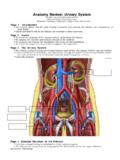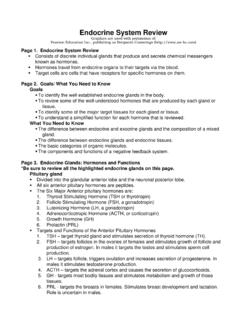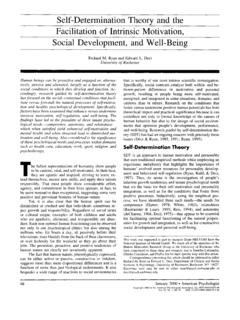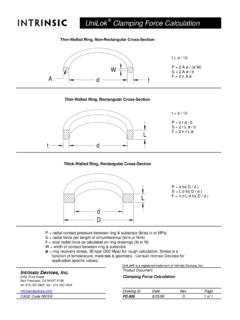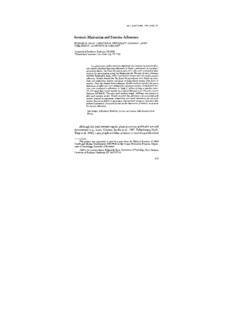Transcription of Intrinsic Conduction System - …
1 Intrinsic Conduction SystemGraphics are used with permission of:Pearson Education Inc., publishing as Benjamin Cummings ( )Page 1. Introduction The Intrinsic Conduction System sets the basic rhythm of the beating heart. It consists of autorhythmic cardiac cells that initiate and distribute impulses (action potentials) throughout the 2. Goals To identify the components of the Intrinsic Conduction System . To recognize that the Intrinsic Conduction System coordinates heart activity by determining the direction and speed of heartdepolarization. To relate heart electrical activity to an ECG wave 3. Intrinsic Conduction System This diagram shows the location of the autorhythmic, or nodal cells of the Intrinsic Conduction System :SA NodeInternodal PathwayAV NodeAV BundleBundle BranchesPurkinje Fibers Label this diagram:Page 4. Pathway of DepolarizationSA Node Located in upper right atrium.
2 Initiates the depolarization impulse which, in turn, generates an action potential that spreads throughout the atria to theAV node. Sets the overall pace of the Pathway Located in the walls of the atria. Links the SA node to the AV node. Distributes the action potential to the contractile cells of the Node Located in the inferior interatrial septum. The action potential is delayed here briefly, while the atria contract, before being transmitted to the AV Bundle The only electrical connection between the atria and the ventricles. Allows the action potential to move from the interatrial septum to the interventricular septum, connecting the AV nodeto the Bundle Branches Convey the action potential down the interventricular Fibers Begin at the lower interventricular septum to the apex of the heart, then continue superiorly through the myocardium ofthe ventricles.
3 The Purkinje fibers convey the action potential to the contractile cells of the ventricle. Action potentials, which spread from the autorhythmic cells of the Intrinsic Conduction System to the contractile cellsare electrical events. Subsequent contraction of the contractile cells is a mechanical event that causes a heartbeat.** Now is a good time to go to quiz question 1: Click the Quiz button on the left side of the screen. After answering question 1, click the Back to Topic button on the left side of the screen. To get back to where you left off, click on the scrolling page list at the top of the screen and choose "5. ECG Wave".Page 5. ECG WaveECG Waves:P Wave Small upward wave. Indicates atrial Wave Downward deflection, then a large upward peak, ending as a downward deflection. Represents ventricular Wave Dome-shaped wave. Represents ventricular repolarization.
4 In a normal ECG tracing, atrial repolarization is hidden by the QRS complex. On the following diagram indicate where the following normally occur:atrial depolarization, ventricular depolarization, ventricular repolarization, atrial repolarization** Now is a good time to go to quiz question 2: Click the Quiz button on the left side of the screen. Click on the scrolling page list at the top of the screen and choose "2. ECG Puzzle". After answering question 2, click the Back to Topic button on the left side of the screen. To get back to where you left off, click on the scrolling page list at the top of the screen and choose "6. Heart & ECGWave".Page 6. Heart and ECG Comparison The contraction of the ventricle begins at the apex of the heart and moves superiorly, forcing the blood upward toward thearteries. This is important because the large arteries are located superiorly.
5 So blood has to be rung from the bottom ofthe heart up. Correlation between heart electrical activity and an ECG wave tracing:P wave Indicates atrial depolarization which is followed by atrial complex Represents ventricular depolarization which is followed by ventricular wave Represents ventricular repolarization which is followed by ventricular 7. Summary The Intrinsic Conduction System of the heart initiates depolarization impulses. Action potentials spread throughout the heart, causing coordinated heart contraction. An ECG wave tracing records the electrical activity of the heart.** Now is a good time to go to quiz questions 3 and 4: Click the Quiz button on the left side of the screen. Click on the scrolling page list at the top of the screen and choose "3a. Left Bundle branch Block". Work through questions 3a, 3b, and on Quiz Questions:Quiz Question #1.
6 Conduction Pathway This question asks you to match the various autorhythmic cells of heart to their Question # 2. ECG Puzzle This question asks you to piece together a normal ECG Question #3a & 3b. Create Left Bundle Branch Block This question asks you to create a left bundle branch block and predict what would happen to the ECG tracing. If you have a difficult time understanding the correct answer, please note that normally the left ventricle is depolarizedwhen impulses move along the left bundle branch and to the Purkinje fibers. If the left bundle branch is blocked,ventricular depolarization takes longer because impulses in the left ventricle must travel from cell to cell. Becauseventricular depolarization is taking longer, the QRS complex is Question #4. ECG for Tachycardia This question allows you to chose the ECG Wave tracing that corresponds to Tachycardia With a normal heart rate of 75 beats per minute, one heartbeat takes seconds.
7 (1 minute/75 beats) (60 seconds/1 minute) = seconds An abnormally fast heart rate, such as 120 beats per minutes, one heartbeat takes seconds.(1 minute/120 beats) (60 seconds/1 minute) = secondsStudy Questions on the Intrinsic Conduction System :1. (Page 1.) What is the purpose of the Intrinsic Conduction System of the heart?2. (Page 1.) What type of cells are present in the Intrinsic Conduction System of the heart?3. (Page 3.) List the six areas within the heart where autorhythmic cells are (Page 4.) Match the six areas within the heart where autorhythmic cells are found to their location within the Within the Heart:a. Interatrial septum to the interventricular Lower interventricular septum to the myocardium ofthe Inferior interatrial Upper right Throughout the walls of the Within the interventricular Where Autorhythmic Cells Are Found:Internodal PathwayAV NodeBundle BranchesSA NodePurkinje FibersAV Bundle5.
8 (Page 4.) Match the six areas within the heart where autorhythmic cells are found to their :a. Initiates the depolarization impulse thatgenerates an action potential, setting theoverall pace of the Convey the action potential to the contractilecells of the Delays the action potential while the Links the SA node to the AV node,distributing the action potential to thecontractile cells of the Electrically connects the atria and theventricles, connecting the AV node to theBundle Conveys the action potential down theinterventricular Where Autorhythmic Cells Are Found:Internodal PathwayAV NodeBundle BranchesSA NodePurkinje FibersAV Bundle6. (Page 4.) Explain the difference between the electrical and mechanical events which occur within the heart, and explain the celltypes that carry out each.
9 Which occurs first, the electrical or mechanical events?7. (Page 5.) In an ECG tracing, how are the following represented:a. atrial atrial repolarizationc. ventricular depolarizationd. ventricular (Page 6.) Why is it important for the contraction of the ventricle to begin at the apex and move (Page 6.) a. The P wave indicates the electrical event of atrial depolarization. What mechanical event follows the P wave?b. The QRS complex indicates the electrical event of ventricular depolarization. What mechanical event follows the QRScomplex?c. The T wave indicates the electrical event of ventricular repolarization. What mechanical event follows the T wave ?10. (Page 6.) Match the appearance of the heart to its position on the ECG tracing.
